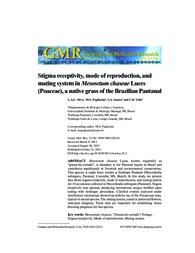Stigma receptivity, mode of reproduction, and mating system in Mesosetum chaseae luces (Poaceae), a native grass of the Brazilian Pantanal.
Stigma receptivity, mode of reproduction, and mating system in Mesosetum chaseae luces (Poaceae), a native grass of the Brazilian Pantanal.
Author(s): SILVA, L. A. C.; PAGLIARINI, M. S.; SANTOS, S. A.; VALLE, C. B. do
Summary: Mesosetum chaseae Luces, known regionally as "grama-do-cerrado", is abundant in the Pantanal region in Brazil and contributes significantly to livestock and environmental conservation. This species is under basic studies at Embrapa Pantanal (Nhecolândia subregion, Pantanal, Corumbá, MS, Brazil). In this study, we present data about stigma receptivity, mode of reproduction, and mating system for 10 accessions collected in Nhecolândia subregion (Pantanal). Stigma receptivity was optimal, producing innumerous oxygen bubbles upon testing with hydrogen peroxidase. Clarified ovaries analyzed under interference microscopy showed an embryo sac of the Polygonum type, typical of sexual species. The mating system, tested in protected flowers, indicated allogamy. These data are important for subsidizing future breeding programs for this species.
Publication year: 2013
Types of publication: Journal article
Unit: Embrapa Pantanal
Observation
Some of Embrapa's publications are published as ePub files. To read them, use or download one of the following free software options to your computer or mobile device. Android: Google Play Books; IOS: iBooks; Windows and Linux: Calibre.
Access other publications
Access the Agricultural Research Database (BDPA) to consult Embrapa's full library collection and records.
Visit Embrapa Bookstore to purchase books and other publications sold by Embrapa.

